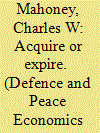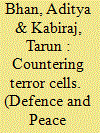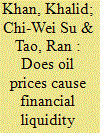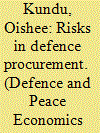|
|
|
Sort Order |
|
|
|
Items / Page
|
|
|
|
|
|
|
| Srl | Item |
| 1 |
ID:
178021


|
|
|
|
|
| Summary/Abstract |
The U.S. government increasingly outsources important national security responsibilities to defense contractors. In addition to manufacturing hardware and weapons, corporations now supply much of the specialized labor used by American defense and intelligence agencies to execute cyber operations, train foreign militaries, analyze top-secret information, and pilot unmanned aerial vehicles. This study examines the current state of affairs in the U.S. defense industry and demonstrates that publicly traded corporations are awarded the lion’s share of U.S. contracting dollars spent on national defense. Subsequently, the inquiry argues that publicly traded corporations possess a competitive advantage over privately held companies in the U.S. defense industry because of their superior ability to raise capital through initial public offerings, follow-on share sales, and access to debt supplied by financial institutions. In recent years, publicly traded defense contractors have used these financial strategies to make major acquisitions, increase their competitiveness, and consolidate market share in the American defense industry.
|
|
|
|
|
|
|
|
|
|
|
|
|
|
|
|
| 2 |
ID:
178019


|
|
|
|
|
| Summary/Abstract |
The analysis provides insights regarding the suitability of offensive versus defensive measures in countering a terror cell. It is shown that the optimal resource allocation is more offensive when the cell is aware of which targets have been protected, but does not distinguish between the values of different targets; than the case where it neither distinguishes between target values nor is the protection conspicuous. Also, the ability of the terror cell to inflict damage is least when it neither distinguishes between target values nor is the target protection conspicuous, and most when it shares the counter-terrorists’ target valuations and observes target protection. Hence, from the counter-terrorism (CT) point of view, there seems to be a rationale in making CT target valuations and target protection inconspicuous to the extent possible. The paper finally deals with the possibility of diverging target valuations from the CT standpoint and that of the terror cell and shows that if target protection is conspicuous to the cell and these are common knowledge, then the optimal CT allocation is at least as offensive as the case with identical valuation rankings.
|
|
|
|
|
|
|
|
|
|
|
|
|
|
|
|
| 3 |
ID:
178020


|
|
|
|
|
| Summary/Abstract |
This study measures whether oil prices affect financial liquidity (FL) in the Kingdom of Saudi Arabi (KSA). The results indicate a positive association between oil prices (OP) and FL in the medium run. FL led OP in the short run during the global financial recession, when the KSA used foreign reserves to stabilize the impact of low OP. Similarly, geopolitical risk (GR) led OP in the medium term and had a positive influence on FL in the short term, especially during periods of higher uncertainty. The correlation between OP and FL becomes more noticeable in the medium term in the presence of GR. Short-run volatility can exert pressure on foreign reserves, which can be effectively managed by keeping reserves in the national currency. Similarly, economic growth sources other than oil income and a peaceful solution to regional differences can reduce defense spending.
|
|
|
|
|
|
|
|
|
|
|
|
|
|
|
|
| 4 |
ID:
178018


|
|
|
|
|
| Summary/Abstract |
Though populist politicians deem the terrorist threat as a reason for restrictive immigration policies, existing studies neglect to explore the systematic connection between immigration and security. This study offers a novel theoretical argument about the effect of terrorism on immigration policy and then conducts a first-cut empirical analysis. Based on a battery of statistical tests performed against pooled panel data on immigrant-receiving countries that are attractive to low-skilled workers due to high wages, this study shows evidence that terrorist threats are actually unrelated to restrictive immigration policies.
|
|
|
|
|
|
|
|
|
|
|
|
|
|
|
|
| 5 |
ID:
178023


|
|
|
|
|
| Summary/Abstract |
This paper employs a wavelet approach to investigate the relationship between economic growth and military spending in a time-frequency domain for the case of Turkey. Turkey presents an interesting case for analysis of military spending and economic growth, as its geopolitical position and history of insurgencies and separatist violence oblige the country to devote an unusually large share of the central government budget to national defence. Timescale regression analysis reveals that military expenditures have significant negative effects on growth in per capita GDP at business cycles of 16 years and longer. Timescale Granger causality analysis indicates that per capita GDP growth responds to movements in military expenditures at business cycles of eight years and above and that this result is very significant. Wavelet coherency analysis corroborates these findings, indicating a significant negative long-run co-movement at business cycles of 16 years and longer. Thus, the neoclassical prediction that military spending may promote growth does not hold in the case of Turkey, at least in the long run. Furthermore, the analysis reveals that, in the long run, military spending has been leading rather than lagging economic growth.
|
|
|
|
|
|
|
|
|
|
|
|
|
|
|
|
| 6 |
ID:
178022


|
|
|
|
|
| Summary/Abstract |
Although there exist several remarkable theories that facilitate the understanding of procurement risks in imperfect market conditions, methods to quantify the impact and identify the most severe risks are less well known. This paper uses the method of risk analysis to discuss defence procurement challenges in India. An original dataset of 88 contracts has been created to identify the most probable and the most severe causes for poor procurement performance. A schedule performance parameter has been constructed to quantify the impact of different adverse events. The findings display a high probability of technological risks followed by contractual risks as the cause for delays in Indian defence procurement. Technological risks are concentrated in cases of indigenous procurement due to a lack of infrastructure and resources while contractual risks mostly occur in contracts where the Ministry of Defence deals with external agents like foreign suppliers. This indicates frictions and transaction costs. These and other findings from the quantitative data on procurement performance are supplemented by insights from an extensive fieldwork in India which included 53 interviews.
|
|
|
|
|
|
|
|
|
|
|
|
|
|
|
|
| 7 |
ID:
178017


|
|
|
|
|
| Summary/Abstract |
This paper models ‘no war, no peace’ situations in a game theoretical framework where two countries are engaged in a standoff over a military sector. The first main objective is to identify rational grounds for such situations and, more precisely, for the explicit equilibria that lead to such situations. It is demonstrated that both countries gain the same payoff from being in this continuous state of perpetual hostility and, moreover, that ‘no war, no peace’ situations can be explained only if the countries perceive an equal measure of military advantage from controlling the area. Given this insight, the second objective of the paper is to provide insights about how ‘no war, no peace’ situations can be resolved. Two different pathways are suggested. The first is idealistic and based on mutual trust, whereas the second is based on deterrence, involving both countries imposing a threat of using armed force against the other country in their respective military doctrines.
|
|
|
|
|
|
|
|
|
|
|
|
|
|
|
|
|
|
|
|
|